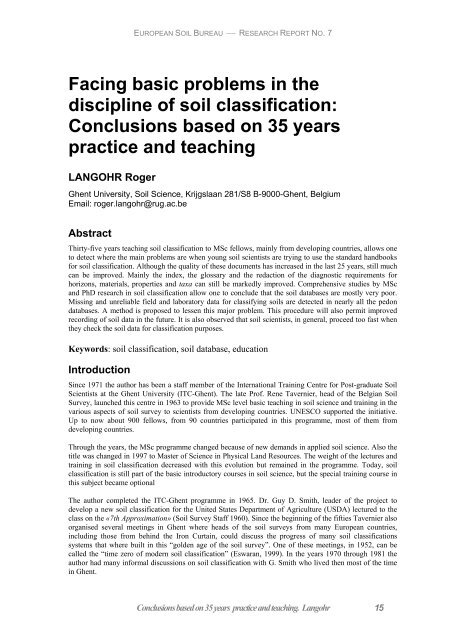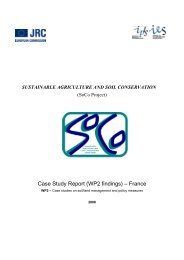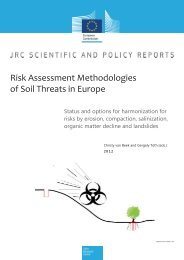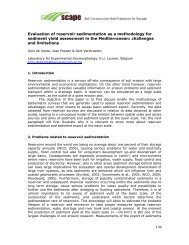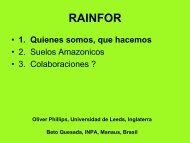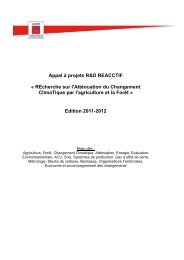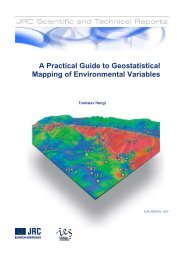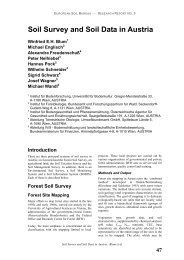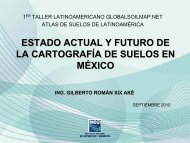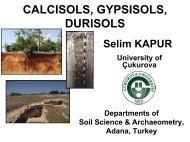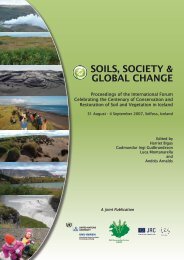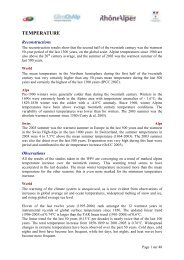Facing basic problems in the discipline of soil classification
Facing basic problems in the discipline of soil classification
Facing basic problems in the discipline of soil classification
Create successful ePaper yourself
Turn your PDF publications into a flip-book with our unique Google optimized e-Paper software.
EUROPEAN SOIL BUREAU ⎯ RESEARCH REPORT NO. 7<br />
<strong>Fac<strong>in</strong>g</strong> <strong>basic</strong> <strong>problems</strong> <strong>in</strong> <strong>the</strong><br />
discipl<strong>in</strong>e <strong>of</strong> <strong>soil</strong> <strong>classification</strong>:<br />
Conclusions based on 35 years<br />
practice and teach<strong>in</strong>g<br />
LANGOHR Roger<br />
Ghent University, Soil Science, Krijgslaan 281/S8 B-9000-Ghent, Belgium<br />
Email: roger.langohr@rug.ac.be<br />
Abstract<br />
Thirty-five years teach<strong>in</strong>g <strong>soil</strong> <strong>classification</strong> to MSc fellows, ma<strong>in</strong>ly from develop<strong>in</strong>g countries, allows one<br />
to detect where <strong>the</strong> ma<strong>in</strong> <strong>problems</strong> are when young <strong>soil</strong> scientists are try<strong>in</strong>g to use <strong>the</strong> standard handbooks<br />
for <strong>soil</strong> <strong>classification</strong>. Although <strong>the</strong> quality <strong>of</strong> <strong>the</strong>se documents has <strong>in</strong>creased <strong>in</strong> <strong>the</strong> last 25 years, still much<br />
can be improved. Ma<strong>in</strong>ly <strong>the</strong> <strong>in</strong>dex, <strong>the</strong> glossary and <strong>the</strong> redaction <strong>of</strong> <strong>the</strong> diagnostic requirements for<br />
horizons, materials, properties and taxa can still be markedly improved. Comprehensive studies by MSc<br />
and PhD research <strong>in</strong> <strong>soil</strong> <strong>classification</strong> allow one to conclude that <strong>the</strong> <strong>soil</strong> databases are mostly very poor.<br />
Miss<strong>in</strong>g and unreliable field and laboratory data for classify<strong>in</strong>g <strong>soil</strong>s are detected <strong>in</strong> nearly all <strong>the</strong> pedon<br />
databases. A method is proposed to lessen this major problem. This procedure will also permit improved<br />
record<strong>in</strong>g <strong>of</strong> <strong>soil</strong> data <strong>in</strong> <strong>the</strong> future. It is also observed that <strong>soil</strong> scientists, <strong>in</strong> general, proceed too fast when<br />
<strong>the</strong>y check <strong>the</strong> <strong>soil</strong> data for <strong>classification</strong> purposes.<br />
Keywords: <strong>soil</strong> <strong>classification</strong>, <strong>soil</strong> database, education<br />
Introduction<br />
S<strong>in</strong>ce 1971 <strong>the</strong> author has been a staff member <strong>of</strong> <strong>the</strong> International Tra<strong>in</strong><strong>in</strong>g Centre for Post-graduate Soil<br />
Scientists at <strong>the</strong> Ghent University (ITC-Ghent). The late Pr<strong>of</strong>. Rene Tavernier, head <strong>of</strong> <strong>the</strong> Belgian Soil<br />
Survey, launched this centre <strong>in</strong> 1963 to provide MSc level <strong>basic</strong> teach<strong>in</strong>g <strong>in</strong> <strong>soil</strong> science and tra<strong>in</strong><strong>in</strong>g <strong>in</strong> <strong>the</strong><br />
various aspects <strong>of</strong> <strong>soil</strong> survey to scientists from develop<strong>in</strong>g countries. UNESCO supported <strong>the</strong> <strong>in</strong>itiative.<br />
Up to now about 900 fellows, from 90 countries participated <strong>in</strong> this programme, most <strong>of</strong> <strong>the</strong>m from<br />
develop<strong>in</strong>g countries.<br />
Through <strong>the</strong> years, <strong>the</strong> MSc programme changed because <strong>of</strong> new demands <strong>in</strong> applied <strong>soil</strong> science. Also <strong>the</strong><br />
title was changed <strong>in</strong> 1997 to Master <strong>of</strong> Science <strong>in</strong> Physical Land Resources. The weight <strong>of</strong> <strong>the</strong> lectures and<br />
tra<strong>in</strong><strong>in</strong>g <strong>in</strong> <strong>soil</strong> <strong>classification</strong> decreased with this evolution but rema<strong>in</strong>ed <strong>in</strong> <strong>the</strong> programme. Today, <strong>soil</strong><br />
<strong>classification</strong> is still part <strong>of</strong> <strong>the</strong> <strong>basic</strong> <strong>in</strong>troductory courses <strong>in</strong> <strong>soil</strong> science, but <strong>the</strong> special tra<strong>in</strong><strong>in</strong>g course <strong>in</strong><br />
this subject became optional<br />
The author completed <strong>the</strong> ITC-Ghent programme <strong>in</strong> 1965. Dr. Guy D. Smith, leader <strong>of</strong> <strong>the</strong> project to<br />
develop a new <strong>soil</strong> <strong>classification</strong> for <strong>the</strong> United States Department <strong>of</strong> Agriculture (USDA) lectured to <strong>the</strong><br />
class on <strong>the</strong> «7th Approximation» (Soil Survey Staff 1960). S<strong>in</strong>ce <strong>the</strong> beg<strong>in</strong>n<strong>in</strong>g <strong>of</strong> <strong>the</strong> fifties Tavernier also<br />
organised several meet<strong>in</strong>gs <strong>in</strong> Ghent where heads <strong>of</strong> <strong>the</strong> <strong>soil</strong> surveys from many European countries,<br />
<strong>in</strong>clud<strong>in</strong>g those from beh<strong>in</strong>d <strong>the</strong> Iron Curta<strong>in</strong>, could discuss <strong>the</strong> progress <strong>of</strong> many <strong>soil</strong> <strong>classification</strong>s<br />
systems that where built <strong>in</strong> this “golden age <strong>of</strong> <strong>the</strong> <strong>soil</strong> survey”. One <strong>of</strong> <strong>the</strong>se meet<strong>in</strong>gs, <strong>in</strong> 1952, can be<br />
called <strong>the</strong> “time zero <strong>of</strong> modern <strong>soil</strong> <strong>classification</strong>” (Eswaran, 1999). In <strong>the</strong> years 1970 through 1981 <strong>the</strong><br />
author had many <strong>in</strong>formal discussions on <strong>soil</strong> <strong>classification</strong> with G. Smith who lived <strong>the</strong>n most <strong>of</strong> <strong>the</strong> time<br />
<strong>in</strong> Ghent.<br />
Conclusions based on 35 years practice and teach<strong>in</strong>g. Langohr 15
EUROPEAN SOIL BUREAU ⎯ RESEARCH REPORT NO. 7<br />
In 1971 <strong>the</strong> author became a permanent staff member <strong>of</strong> <strong>the</strong> ITC-Ghent and was responsible, <strong>in</strong> <strong>the</strong><br />
beg<strong>in</strong>n<strong>in</strong>g for <strong>the</strong> tra<strong>in</strong><strong>in</strong>g, and later also for <strong>the</strong> <strong>basic</strong> teach<strong>in</strong>g <strong>in</strong> <strong>soil</strong> <strong>classification</strong>. In <strong>the</strong>se years <strong>the</strong> ITC-<br />
Ghent programme focussed on both <strong>the</strong> FAO and <strong>the</strong> USDA <strong>soil</strong> taxonomies. This document provides an<br />
overview <strong>of</strong> <strong>the</strong> <strong>problems</strong> met by MSc students and PhD fellows, ma<strong>in</strong>ly from develop<strong>in</strong>g countries, when<br />
learn<strong>in</strong>g and tra<strong>in</strong><strong>in</strong>g <strong>in</strong> <strong>the</strong>se two taxonomies. It also reflects <strong>the</strong> difficulties <strong>the</strong> author met when apply<strong>in</strong>g<br />
<strong>the</strong>se documents <strong>in</strong> his research and <strong>soil</strong> survey activities.<br />
In order to facilitate <strong>the</strong> fur<strong>the</strong>r read<strong>in</strong>g <strong>the</strong> follow<strong>in</strong>g abbreviations will be used.<br />
• 7 th Approximation: Soil Survey Staff 1960.<br />
• US ST 1975 and US ST 1999: first and second edition <strong>of</strong> <strong>the</strong> comprehensive handbook about <strong>the</strong><br />
USDA Soil Taxonomy (Soil Survey Staff 1975 and 1999).<br />
• US ST 1998: <strong>the</strong> eighth edition <strong>of</strong> <strong>the</strong> “Keys to Soil Taxonomy” (Soil Survey Staff 1998).<br />
• FAO 1974: Legend <strong>of</strong> <strong>the</strong> FAO-UNESCO Soil Map <strong>of</strong> <strong>the</strong> World (FAO-UNESCO 1974).<br />
• FAO 1990: <strong>the</strong> Revised legend, Repr<strong>in</strong>ted (FAO 1990a).<br />
• WRB 1998: <strong>the</strong> most recent edition <strong>of</strong> <strong>the</strong> World Reference Base for Soil Resources<br />
(ISSS/ISRIC/FAO 1998).<br />
• FAO, ST, WRB: <strong>the</strong> respective <strong>classification</strong> systems without precision <strong>of</strong> <strong>the</strong> edition.<br />
For <strong>the</strong> <strong>soil</strong> <strong>classification</strong> systems discussed <strong>in</strong> this paper, we consider <strong>the</strong> terms <strong>classification</strong> and<br />
taxonomy as synonyms. Also <strong>the</strong> FAO system is a taxonomy. It is not because it was built up as a tool for<br />
mapp<strong>in</strong>g <strong>soil</strong>s that it would not be a taxonomic system but only a <strong>soil</strong> map legend (FAO 1990a, page 8). If<br />
this approach would be accepted, most <strong>classification</strong> systems, <strong>in</strong>clud<strong>in</strong>g US ST, would not be <strong>classification</strong><br />
systems, or taxonomies.<br />
What and how to teach<br />
Teach<strong>in</strong>g <strong>soil</strong> <strong>classification</strong>, just as any o<strong>the</strong>r <strong>classification</strong> system, can be a relatively easy task. After an<br />
<strong>in</strong>troductory chapter where <strong>the</strong> <strong>basic</strong> term<strong>in</strong>ology <strong>of</strong> <strong>the</strong> discipl<strong>in</strong>e is expla<strong>in</strong>ed, <strong>the</strong> whole <strong>classification</strong><br />
system can be discussed <strong>in</strong> length and width. Eventually some exercises can complete <strong>the</strong> programme. This<br />
approach is considered bor<strong>in</strong>g by most students and favours large memory capacities ra<strong>the</strong>r than<br />
comprehension <strong>of</strong> how to deal correctly with <strong>the</strong> subject.<br />
At ITC-Ghent <strong>the</strong> teach<strong>in</strong>g programme was oriented toward prepar<strong>in</strong>g students to classify <strong>soil</strong>s correctly<br />
ra<strong>the</strong>r than memoris<strong>in</strong>g numerous diagnostic requirements and taxa. An MSc degree is a high level <strong>of</strong><br />
university teach<strong>in</strong>g. It is <strong>the</strong> responsibility <strong>of</strong> <strong>the</strong> teach<strong>in</strong>g staff to prepare pr<strong>of</strong>essionals who, after <strong>the</strong><br />
programme, can perform <strong>the</strong> job alone.<br />
Preference was given to:<br />
• teach<strong>in</strong>g <strong>the</strong> rationale beh<strong>in</strong>d <strong>the</strong> systems,<br />
• warn<strong>in</strong>g <strong>of</strong> <strong>problems</strong> <strong>in</strong> <strong>the</strong> discipl<strong>in</strong>e as related to:<br />
o reputation,<br />
o quality <strong>of</strong> handbooks,<br />
o quality <strong>of</strong> database,<br />
o complexity <strong>of</strong> term<strong>in</strong>ology,<br />
o complexity <strong>of</strong> keys for determ<strong>in</strong>ation,<br />
• tra<strong>in</strong><strong>in</strong>g on how to face <strong>the</strong>se <strong>problems</strong> <strong>in</strong> order to classify <strong>soil</strong>s correctly.<br />
Guy D. Smith mentioned <strong>in</strong> his Interviews (Smith 1986) that it was decided not to expla<strong>in</strong> <strong>in</strong> <strong>the</strong> US ST<br />
handbook <strong>the</strong> reasons beh<strong>in</strong>d <strong>the</strong> decisions on <strong>the</strong> diagnostic criteria and def<strong>in</strong>itions. The rationale was that<br />
readers would pay too much attention to <strong>the</strong>se reasons, ra<strong>the</strong>r than on <strong>the</strong> def<strong>in</strong>itions <strong>the</strong>mselves. However,<br />
when we have to teach such a complex matter, <strong>the</strong> <strong>in</strong>formation provided to <strong>the</strong> students about <strong>the</strong> rationale<br />
is very important to help <strong>the</strong>m l<strong>in</strong>k <strong>the</strong> ra<strong>the</strong>r abstract term<strong>in</strong>ology and <strong>the</strong> diagnostic criteria to <strong>the</strong><br />
<strong>problems</strong> met <strong>in</strong> <strong>the</strong> various applied aspects <strong>of</strong> <strong>soil</strong> science. From this po<strong>in</strong>t <strong>of</strong> view <strong>the</strong> publication <strong>of</strong> <strong>the</strong><br />
Guy Smith Interviews (Smith 1986), eleven years after <strong>the</strong> first edition <strong>of</strong> US ST, was very helpful.<br />
<strong>Fac<strong>in</strong>g</strong> <strong>the</strong> status horribilis <strong>of</strong> <strong>soil</strong> <strong>classification</strong> as a discipl<strong>in</strong>e<br />
Overall, <strong>soil</strong> <strong>classification</strong> has a poor reputation. Severe criticism on <strong>the</strong> discipl<strong>in</strong>e is not uncommon.<br />
Comments such as “too many <strong>classification</strong> systems”, “chang<strong>in</strong>g too frequently”, “too many<br />
characteristics”, “data too difficult to obta<strong>in</strong>”, “too complex”, “too difficult term<strong>in</strong>ology”, “specialists<br />
16<br />
Conclusions based on 35 years practice and teach<strong>in</strong>g. Langohr
EUROPEAN SOIL BUREAU ⎯ RESEARCH REPORT NO. 7<br />
disagree on <strong>the</strong> exact names <strong>of</strong> <strong>the</strong> <strong>soil</strong>s”, “useless” are frequently heard. Pronounced by outsiders, <strong>the</strong>se<br />
could be understandable. Unfortunately such sentences are also heard from <strong>soil</strong> science colleagues. In <strong>the</strong><br />
presence <strong>of</strong> scientists from o<strong>the</strong>r discipl<strong>in</strong>es, students, or layman, this has a damag<strong>in</strong>g impact on <strong>the</strong> status<br />
<strong>of</strong> <strong>soil</strong> science <strong>in</strong> general. This bad reputation is at least partly responsible for <strong>soil</strong> <strong>classification</strong> be<strong>in</strong>g<br />
absent from many teach<strong>in</strong>g programmes <strong>in</strong> <strong>soil</strong> science. Many younger <strong>soil</strong> scientists do not receive any<br />
tra<strong>in</strong><strong>in</strong>g <strong>in</strong> classify<strong>in</strong>g <strong>soil</strong>s and thus, <strong>the</strong>y do not even comprehend a <strong>classification</strong> system.<br />
A large part <strong>of</strong> this criticism about <strong>soil</strong> <strong>classification</strong> is not valid. The existence <strong>of</strong> many <strong>classification</strong><br />
systems, based on <strong>soil</strong> characteristics that are frequently updated, should be considered as “normal”. The<br />
ma<strong>in</strong> arguments are <strong>the</strong> follow<strong>in</strong>g.<br />
• Soils have a very high number <strong>of</strong> morphological, chemical, physical, m<strong>in</strong>eralogical characteristics.<br />
• The applications <strong>of</strong> <strong>soil</strong> science are numerous and deal with topics such as fertility for crop<br />
production, irrigation/dra<strong>in</strong>age, rangeland management, forest productivity, waste deposits,<br />
pollution risks, toxicity remediation, sport fields, palaeo-environment reconstruction, nature<br />
reserve management, road and house construction, and urban plann<strong>in</strong>g. Each <strong>of</strong> <strong>the</strong>se discipl<strong>in</strong>es<br />
constructs a different hierarchy <strong>of</strong> importance among <strong>the</strong> numerous <strong>soil</strong> characteristics.<br />
• In zoology and botany, <strong>in</strong> natural conditions, sexuality largely rules <strong>the</strong> comb<strong>in</strong>ations that are<br />
possible. This allows consider<strong>in</strong>g all races <strong>of</strong> dogs and all races <strong>of</strong> cats as two dist<strong>in</strong>ct species.<br />
Also <strong>in</strong> m<strong>in</strong>eralogy and petrography numerous comb<strong>in</strong>ations <strong>of</strong> elements are impossible because<br />
<strong>of</strong> <strong>the</strong> crystal structures or <strong>the</strong> exclusivity among chemical components. In <strong>soil</strong>s, on <strong>the</strong> contrary, it<br />
is difficult to formulate strict rules about <strong>the</strong> exclusivity among <strong>the</strong> numerous characteristics. This<br />
is because <strong>soil</strong>s are capable <strong>of</strong> reta<strong>in</strong><strong>in</strong>g characteristics that are related to past environmental<br />
conditions. It is, for example, possible to observe:<br />
o <strong>soil</strong>s with a Bt horizon also conta<strong>in</strong><strong>in</strong>g secondary carbonates;<br />
o <strong>soil</strong>s ma<strong>in</strong>ly composed <strong>of</strong> kaol<strong>in</strong>ite clay and iron sesquioxides, but also conta<strong>in</strong><strong>in</strong>g<br />
secondary calcium carbonate;<br />
o <strong>soil</strong>s display<strong>in</strong>g, characteristics <strong>of</strong> a hydromorphic <strong>soil</strong> <strong>in</strong> an area where <strong>the</strong>re is no<br />
groundwater table present today;<br />
o deeply wea<strong>the</strong>red <strong>soil</strong>s with fresh volcanic glass <strong>in</strong> <strong>the</strong> surface horizons;<br />
o sandy <strong>soil</strong>s with high amount <strong>of</strong> wea<strong>the</strong>rable m<strong>in</strong>erals <strong>in</strong> an area with strongly leach<strong>in</strong>g<br />
equatorial climate.<br />
• Boundaries among <strong>soil</strong>s are rarely sharp. The transition between well dra<strong>in</strong>ed and poorly dra<strong>in</strong>ed<br />
<strong>soil</strong>s will usually pass through moderately well and imperfectly dra<strong>in</strong>ed <strong>soil</strong>s. This statement can<br />
be made for nearly all <strong>soil</strong> characteristics. This fuzz<strong>in</strong>ess makes <strong>the</strong> def<strong>in</strong>ition <strong>of</strong> clearly def<strong>in</strong>ed<br />
taxa particularly difficult.<br />
• In different regions <strong>of</strong> <strong>the</strong> world, <strong>soil</strong>scapes are composed <strong>of</strong> different <strong>soil</strong> types. Soil<br />
<strong>classification</strong>s built up on a regional, national or even cont<strong>in</strong>ental basis will be different from<br />
<strong>classification</strong>s cover<strong>in</strong>g o<strong>the</strong>r regions, nations or cont<strong>in</strong>ents.<br />
• Construction <strong>of</strong> a <strong>classification</strong> depends on a number <strong>of</strong> <strong>soil</strong>s be<strong>in</strong>g known and sufficiently<br />
characterized. We are far from characteriz<strong>in</strong>g <strong>the</strong> majority <strong>of</strong> <strong>soil</strong>s <strong>in</strong> <strong>the</strong> world. Particularly those<br />
<strong>soil</strong>s outside <strong>the</strong> ma<strong>in</strong> crop grow<strong>in</strong>g regions are less well known. Soil surveys throughout <strong>the</strong><br />
world cont<strong>in</strong>uously supply <strong>the</strong> database with <strong>in</strong>formation on new <strong>soil</strong>s, allow<strong>in</strong>g an ongo<strong>in</strong>g<br />
upgrad<strong>in</strong>g <strong>of</strong> <strong>the</strong> exist<strong>in</strong>g <strong>classification</strong> systems. This mode <strong>of</strong> operation will persist for a long<br />
period.<br />
• From <strong>the</strong> previous paragraphs it can be concluded that it is “normal” that:<br />
• <strong>the</strong>re are many local, regional, national, cont<strong>in</strong>ental and even world <strong>classification</strong> systems,<br />
• <strong>the</strong>se systems are constructed on <strong>the</strong> basis <strong>of</strong> many <strong>soil</strong> characteristics,<br />
• <strong>the</strong> differentiat<strong>in</strong>g characteristics will be different from one system to ano<strong>the</strong>r,<br />
• at least some <strong>of</strong> <strong>the</strong>se systems are regularly updated<br />
The requirement for only one, fixed <strong>soil</strong> <strong>classification</strong> system is not realistic and not even desirable as it<br />
would not represent progress <strong>in</strong> <strong>the</strong> scientific discipl<strong>in</strong>e. However, it is clear that <strong>the</strong>re is a need for at least<br />
one <strong>classification</strong> system, on which most scientists can agree, that covers <strong>the</strong> ma<strong>in</strong> <strong>soil</strong> types <strong>of</strong> <strong>the</strong> world.<br />
Such a taxonomy is useful for worldwide correlation and serves as a reference base for communication<br />
among scientists from different regions and/or with different <strong>in</strong>terests.<br />
Conclusions based on 35 years practice and teach<strong>in</strong>g. Langohr 17
EUROPEAN SOIL BUREAU ⎯ RESEARCH REPORT NO. 7<br />
Who are <strong>the</strong> “<strong>soil</strong> taxonomists”?<br />
In botany and zoology, taxonomists are pr<strong>of</strong>essionals work<strong>in</strong>g full time <strong>in</strong> <strong>the</strong> identification <strong>of</strong> plants and<br />
animals and improv<strong>in</strong>g cont<strong>in</strong>uously <strong>the</strong> taxonomies. In <strong>soil</strong> science, <strong>the</strong> experts <strong>in</strong> <strong>soil</strong> <strong>classification</strong><br />
usually have pr<strong>of</strong>essional activities that are only partly related to this subject. Very few scientists receive<br />
<strong>the</strong> <strong>in</strong>struction to work full-time on this task. Guy D. Smith, who had <strong>the</strong> leadership for many years <strong>of</strong> a<br />
project with<strong>in</strong> <strong>the</strong> Soil Conservation Service <strong>of</strong> <strong>the</strong> USDA to develop a new comprehensive system <strong>of</strong> <strong>soil</strong><br />
<strong>classification</strong>, was such an exception. Thanks to this position, and to his expertise, he managed, toge<strong>the</strong>r<br />
with all <strong>the</strong> collaborat<strong>in</strong>g staff members, to f<strong>in</strong>ally complete <strong>the</strong> 1975 “Soil Taxonomy” Agriculture<br />
Handbook 436 (Soil Survey Staff, 1975). The very useful <strong>in</strong>troductory part <strong>of</strong> this book, where much <strong>of</strong> <strong>the</strong><br />
rationale <strong>of</strong> <strong>the</strong> def<strong>in</strong>itions is expla<strong>in</strong>ed, contrasts with many <strong>of</strong> <strong>the</strong> o<strong>the</strong>r handbooks published before and<br />
even afterwards.<br />
Major <strong>problems</strong> <strong>in</strong> <strong>soil</strong> <strong>classification</strong><br />
All <strong>soil</strong> scientists deal<strong>in</strong>g with <strong>soil</strong> <strong>classification</strong> know that <strong>the</strong>re is very seldom a complete agreement on<br />
<strong>the</strong> name for a <strong>soil</strong> pr<strong>of</strong>ile among colleagues, even when consult<strong>in</strong>g <strong>the</strong> same handbook and <strong>the</strong> same data<br />
base about site, pr<strong>of</strong>ile and analytical data. For example, <strong>the</strong> <strong>classification</strong> <strong>of</strong> 6 pr<strong>of</strong>iles <strong>of</strong> Mozambique by<br />
an <strong>in</strong>ternational panel <strong>of</strong> 12 <strong>soil</strong> experts provided for each pedon on average 8 different names at <strong>the</strong><br />
subgroup level <strong>of</strong> ST (Kauffmann 1987). At <strong>the</strong> order level some <strong>soil</strong>s received 4 different names, rang<strong>in</strong>g,<br />
for example, from Oxisol to Mollisol, Ultisol and Alfisol. We can agree with Kauffman (1987) when he<br />
stated that: “…large differences for same pr<strong>of</strong>iles cannot be allowed <strong>in</strong> any taxonomic system”. The<br />
excellent excursion organised dur<strong>in</strong>g <strong>the</strong> International Symposium on Soil Classification 2001 <strong>in</strong> Hungary<br />
(Anonymous, 2001), attended by a set <strong>of</strong> world specialists <strong>in</strong> <strong>soil</strong> <strong>classification</strong>, illustrated once more <strong>the</strong><br />
disagreement among scientists when provid<strong>in</strong>g names to <strong>the</strong> visited pr<strong>of</strong>iles. Unfortunately <strong>the</strong><br />
discrepancies do not always concern m<strong>in</strong>or details. This situation is one <strong>of</strong> <strong>the</strong> major reasons why <strong>soil</strong><br />
<strong>classification</strong> has poor reputation <strong>in</strong> <strong>the</strong> discipl<strong>in</strong>e <strong>of</strong> <strong>soil</strong> science.<br />
Students should not only be <strong>in</strong>formed about this status, <strong>the</strong>y should also learn about <strong>the</strong> reasons beh<strong>in</strong>d it.<br />
We consider that at least three aspects must be dist<strong>in</strong>guished here.<br />
• Quality <strong>of</strong> <strong>the</strong> handbooks.<br />
• Quality <strong>of</strong> <strong>the</strong> <strong>soil</strong> databases.<br />
• Soil scientists usually proceed too fast when classify<strong>in</strong>g <strong>soil</strong>s.<br />
Quality <strong>of</strong> <strong>the</strong> handbooks<br />
The scarcity <strong>of</strong> full-time <strong>soil</strong> taxonomists is certa<strong>in</strong>ly one <strong>of</strong> <strong>the</strong> reasons why <strong>in</strong>formation and <strong>in</strong>structions<br />
provided by <strong>the</strong> handbooks are seldom sufficiently clear. It appears also that <strong>the</strong> authors have not taken <strong>in</strong>to<br />
account that <strong>the</strong> “users” <strong>of</strong> <strong>the</strong> documents are frequently not well acqua<strong>in</strong>ted with <strong>the</strong> taxonomic systems<br />
and <strong>the</strong> term<strong>in</strong>ology <strong>in</strong> general. This situation made Swanson (1999) propose to simplify <strong>the</strong> US Taxonomy<br />
We will comment here on four ma<strong>in</strong> aspects: (i) <strong>in</strong>formation on term<strong>in</strong>ology, laboratory methods and<br />
concepts, (ii) sentences and edit<strong>in</strong>g, (iii) redaction <strong>of</strong> diagnostic criteria and (iv) <strong>in</strong>formation on how to<br />
proceed.<br />
Information on term<strong>in</strong>ology, laboratory methods and concepts<br />
Soil scientists should be aware that <strong>the</strong> subject <strong>of</strong> <strong>the</strong>ir study is complex. The number <strong>of</strong> chemical, physical,<br />
m<strong>in</strong>eralogical, biological <strong>soil</strong> characteristics is nearly <strong>in</strong>f<strong>in</strong>ite, <strong>the</strong> number <strong>of</strong> reactions and processes is very<br />
large and <strong>the</strong> composition <strong>of</strong> <strong>the</strong> pedosphere necessitates understand<strong>in</strong>g <strong>of</strong> <strong>the</strong> <strong>in</strong>teractions between<br />
atmosphere, lithosphere, biosphere and hydrosphere. When deal<strong>in</strong>g with such a complexity, <strong>the</strong>re is a need<br />
for a precise standard term<strong>in</strong>ology. Here <strong>the</strong> elaboration <strong>of</strong> numerous standard guidel<strong>in</strong>es for <strong>soil</strong> site and<br />
pr<strong>of</strong>ile record<strong>in</strong>g are a very important <strong>in</strong>itiative. It is fortunate that most <strong>of</strong> <strong>the</strong>se guidel<strong>in</strong>es (e.g. FAO<br />
1990b) follow closely <strong>the</strong> term<strong>in</strong>ology proposed by <strong>the</strong> USDA Soil Survey Manual, first edited <strong>in</strong> 1937<br />
(Kellogg 1937) after <strong>the</strong> 1914 field book, which sufficed as <strong>of</strong>ficial written <strong>in</strong>structions until 1937 (Nichols<br />
2002). There exists, however still some discrepancies between <strong>the</strong> various guidel<strong>in</strong>es. For example, <strong>soil</strong><br />
horizon symbols are somewhat different between ST, FAO and WRB.<br />
For laboratory methods, <strong>the</strong> criteria and methods may be different from one <strong>in</strong>stitution to ano<strong>the</strong>r. Many<br />
systems apply <strong>the</strong> 2 µm size limit for clay, but some <strong>in</strong>stitutions put this limit at 1 µm. It is well known that<br />
different laboratory procedures provide different results for <strong>the</strong> same element.<br />
18<br />
Conclusions based on 35 years practice and teach<strong>in</strong>g. Langohr
EUROPEAN SOIL BUREAU ⎯ RESEARCH REPORT NO. 7<br />
A pH measured <strong>in</strong> distilled water will be different when 1/1, 1/5 or 1/10 ratios are applied. Precise<br />
<strong>in</strong>structions should be provided about concepts and methods.<br />
Concern<strong>in</strong>g <strong>the</strong> overall term<strong>in</strong>ology and laboratory methods <strong>the</strong> follow<strong>in</strong>g remarks can be made.<br />
• Each <strong>soil</strong> <strong>classification</strong> handbook should clearly state, <strong>in</strong> <strong>the</strong> <strong>in</strong>troductory chapter, or under materials<br />
and methods, what guidebook for <strong>soil</strong> site and pr<strong>of</strong>ile record<strong>in</strong>g is used and what methods should be<br />
applied for <strong>the</strong> analytical data. The date <strong>of</strong> edition <strong>of</strong> <strong>the</strong>se documents must be stated. Scientists<br />
collect<strong>in</strong>g field and laboratory data should stick to <strong>the</strong>se guidel<strong>in</strong>es.<br />
• It is crucial that precise characteristics receive an exclusive nomenclature. It is proposed, for example,<br />
to replace common words such as mottl<strong>in</strong>g by redoximorphic depletions and accumulations, or<br />
structure by pedality (structure be<strong>in</strong>g ra<strong>the</strong>r <strong>the</strong> result <strong>of</strong> pedality and porosity as documented by<br />
McKeague et al. 1986) or stones by medium size lithic fragments.<br />
• The diagnostic criteria used <strong>in</strong> <strong>the</strong> <strong>classification</strong> handbooks should match with <strong>the</strong> <strong>in</strong>formation<br />
mentioned <strong>in</strong> <strong>the</strong> description guidel<strong>in</strong>es. This is not always so. Two examples illustrate this comment.<br />
o A 7.5 cm transition is diagnostic for an abrupt textural change (FAO, ST); yet <strong>in</strong> <strong>the</strong> pr<strong>of</strong>ile<br />
description guidel<strong>in</strong>es (Soil Survey Staff 1990, FAO 1990b) <strong>the</strong> lower and upper limits <strong>of</strong> a<br />
gradual boundary are 5 and 15 cm. So, <strong>in</strong> case <strong>of</strong> a gradual boundary, one cannot know if <strong>the</strong> clay<br />
<strong>in</strong>crease is reached <strong>in</strong> less or more than 7.5 cm.<br />
o In WRB 1998, <strong>the</strong> “skeletal” unit should have between 40 and 90 percent (by weight) gravel or<br />
o<strong>the</strong>r coarse fragments at a particular depth. However, <strong>in</strong> <strong>the</strong> Guidel<strong>in</strong>es for Soil Description<br />
(FAO 1990b) <strong>the</strong> record<strong>in</strong>g is done <strong>in</strong> volume percentage and <strong>the</strong> 40 and 90 percent are not among<br />
<strong>the</strong> class limits.<br />
• A very high number <strong>of</strong> morphological, physical, chemical, m<strong>in</strong>eralogical, biological characteristics are<br />
dealt with <strong>in</strong> <strong>the</strong> handbooks. When consult<strong>in</strong>g a handbook, <strong>the</strong> precise connotation <strong>of</strong> <strong>the</strong> terms should<br />
be clear. For <strong>the</strong> <strong>soil</strong> descriptive term<strong>in</strong>ology one can refer to <strong>the</strong> already mentioned field guidel<strong>in</strong>es.<br />
These are relatively easy to obta<strong>in</strong> or occur <strong>in</strong> many libraries. Unfortunately a set <strong>of</strong> terms is not<br />
expla<strong>in</strong>ed <strong>in</strong> those documents. They may occur somewhere <strong>in</strong> <strong>the</strong> <strong>classification</strong> handbook, but just<br />
where is a problem. A comprehensive <strong>in</strong>dex is needed. They are not present <strong>in</strong> <strong>the</strong> FAO or WRB<br />
documents. In <strong>the</strong> two editions <strong>of</strong> ST <strong>the</strong>re is an <strong>in</strong>dex, but it is <strong>in</strong>complete (Baillie 2001). A<br />
comprehensive glossary would substantially improve <strong>the</strong> readability <strong>of</strong> <strong>the</strong> documents. A few<br />
examples illustrate this need for an <strong>in</strong>dex and glossary.<br />
• The term “rock structure” is stated among <strong>the</strong> diagnostic criteria for cambic horizons (FAO, ST).<br />
Most <strong>soil</strong> scientists will th<strong>in</strong>k here about hard rock structure. However, <strong>in</strong> both taxonomies it also<br />
<strong>in</strong>cludes stratification <strong>in</strong> sedimentary deposits (i.e. close to <strong>the</strong> concept <strong>of</strong> rock <strong>in</strong> some geology<br />
handbooks). In FAO this approach is not mentioned <strong>in</strong> <strong>the</strong> handbook. In ST it is mentioned <strong>in</strong> one<br />
sentence <strong>in</strong> <strong>the</strong> <strong>in</strong>troductory chapter <strong>of</strong> <strong>the</strong> cambic horizon. Both handbooks lack a glossary where<br />
such specific terms are expla<strong>in</strong>ed. The term “rock structure”, present <strong>in</strong> <strong>the</strong> <strong>in</strong>dex at <strong>the</strong> end <strong>of</strong> ST<br />
1975, is not mentioned <strong>in</strong> <strong>the</strong> <strong>in</strong>dex <strong>of</strong> <strong>the</strong> ST 1999 edition.<br />
• In <strong>soil</strong> science handbooks a dist<strong>in</strong>ction is made between layers, which are supposed to be <strong>the</strong> result <strong>of</strong><br />
geological processes such as sedimentation, versus horizons that are <strong>the</strong> result <strong>of</strong> pedogenetic<br />
processes. In <strong>the</strong> key <strong>of</strong> required characteristics <strong>of</strong> <strong>the</strong> fragipan <strong>in</strong> ST 1999, four <strong>of</strong> <strong>the</strong> five sentences<br />
start with <strong>the</strong> words “The layer…» whereas <strong>the</strong> same fragipan is <strong>in</strong>troduced as an “horizon”.<br />
• In ST <strong>the</strong> term ruptic, and <strong>the</strong> <strong>soil</strong>s with <strong>in</strong>termittent or cyclic horizons are dealt with <strong>in</strong> several<br />
different chapters and paragraphs but are not <strong>in</strong> <strong>the</strong> <strong>in</strong>dex.<br />
• Baillie (2001) mentioned that <strong>the</strong> melanic <strong>in</strong>dex, a criterion for <strong>the</strong> diagnostic melanic epipedon, is not<br />
expla<strong>in</strong>ed <strong>in</strong> <strong>the</strong> sections on <strong>the</strong> melanic epipedon, andic <strong>soil</strong> properties, <strong>the</strong> Andisol chapter, or <strong>in</strong> <strong>the</strong><br />
book’s <strong>in</strong>dex. We found it on page 860, <strong>in</strong> <strong>the</strong> Appendix on “Laboratory Methods for Soil<br />
Taxonomy”, where a series <strong>of</strong> laboratory procedures are listed <strong>in</strong> a non-alphabetic order. In WRB<br />
1998, <strong>the</strong> determ<strong>in</strong>ation method for <strong>the</strong> melanic <strong>in</strong>dex is referred to Honna et al. (1988), a Circular<br />
Letter that is difficult to f<strong>in</strong>d <strong>in</strong> libraries.<br />
• The term “solum” is dealt with <strong>in</strong> all three FAO, WRB and ST systems. In FAO and WRB <strong>the</strong> term is<br />
not expla<strong>in</strong>ed. In ST 1999 <strong>the</strong> term is dealt with <strong>in</strong> at least ten def<strong>in</strong>itions, it is expla<strong>in</strong>ed <strong>in</strong> two l<strong>in</strong>es <strong>in</strong><br />
<strong>the</strong> middle <strong>of</strong> a paragraph <strong>of</strong> <strong>the</strong> <strong>in</strong>troductory chapter on “The Soils That We Classify”, and it is absent<br />
from <strong>the</strong> <strong>in</strong>dex <strong>of</strong> a book with 869 pages.<br />
• It is important to avoid confusion among <strong>the</strong> terms used <strong>in</strong> <strong>the</strong> handbooks. As an example, <strong>in</strong> one <strong>of</strong><br />
<strong>the</strong> <strong>in</strong>troductory paragraphs <strong>of</strong> WRB 1998 structure <strong>of</strong> <strong>the</strong> <strong>soil</strong> is discussed at four levels <strong>of</strong><br />
organization, from elementary organizations such as cutans and nodules, up to pedological systems at<br />
<strong>the</strong> scale <strong>of</strong> <strong>the</strong> landscape. Elsewhere <strong>in</strong> <strong>the</strong> handbook, <strong>the</strong> term <strong>soil</strong> structure is always used as it is<br />
described <strong>in</strong> <strong>the</strong> Guidel<strong>in</strong>es for Soil Description (FAO, 1990), i.e. <strong>the</strong> cluster<strong>in</strong>g <strong>of</strong> elementary particles<br />
Conclusions based on 35 years practice and teach<strong>in</strong>g. Langohr 19
EUROPEAN SOIL BUREAU ⎯ RESEARCH REPORT NO. 7<br />
<strong>in</strong>to aggregates or peds. Such marked difference <strong>in</strong> concept for term<strong>in</strong>ology that is very similar<br />
(structure <strong>of</strong> <strong>the</strong> <strong>soil</strong>s versus <strong>soil</strong> structure) does not make understand<strong>in</strong>g <strong>the</strong> pr<strong>of</strong>essional term<strong>in</strong>ology<br />
easier.<br />
• If simplification <strong>of</strong> <strong>the</strong> diagnostic criteria is possible, it should be applied. As long as <strong>the</strong>y are reliable<br />
for <strong>the</strong> identification <strong>of</strong> <strong>the</strong> diagnostic feature, priority should be given to <strong>the</strong> morphological data. A<br />
def<strong>in</strong>ition such as <strong>the</strong> one for <strong>the</strong> alic properties <strong>in</strong> WRB 1998 should be avoided: <strong>the</strong>re are no<br />
morphological criteria and at least n<strong>in</strong>e laboratory determ<strong>in</strong>ations, some <strong>of</strong> which are not exactly<br />
rout<strong>in</strong>e data, are needed.<br />
Sentences and edit<strong>in</strong>g<br />
Read<strong>in</strong>g <strong>the</strong> taxonomy handbooks, and when check<strong>in</strong>g <strong>the</strong> diagnostic criteria for horizons, properties,<br />
materials or taxa, is <strong>of</strong>ten an arduous task as sentences are not always written <strong>in</strong> a clear language. A<br />
sentence like “…must have: <strong>soil</strong> structure sufficiently strong that <strong>the</strong> horizon is not both massive and hard<br />
or very hard when dry.” among <strong>the</strong> diagnostic criteria <strong>of</strong> <strong>the</strong> mollic horizon, creates much confusion. To<br />
our experience more than ¾ <strong>of</strong> <strong>the</strong> students misunderstand <strong>the</strong> exact <strong>in</strong>tention <strong>of</strong> this sentence and it is not<br />
uncommon to meet colleagues <strong>soil</strong> scientists who also miss it. This sentence is still present <strong>in</strong> WRB 1998;<br />
<strong>in</strong> ST it was changed and improved s<strong>in</strong>ce <strong>the</strong> ST 1998 edition. The construction <strong>of</strong> a key based on<br />
sentences end<strong>in</strong>g with words such as “and”, “or”, “ei<strong>the</strong>r” over a whole page, before one can decide if all<br />
requirements are met or not, demands a very rigorous and attentive read<strong>in</strong>g. Particularly for people who are<br />
not accustomed to read<strong>in</strong>g and comprehend<strong>in</strong>g <strong>of</strong> literature, special tra<strong>in</strong><strong>in</strong>g is needed.<br />
Redaction <strong>of</strong> diagnostic criteria<br />
Great care should be given to <strong>the</strong> def<strong>in</strong>ition <strong>of</strong> required characteristics for diagnostic horizons, properties<br />
and materials. If <strong>the</strong> determ<strong>in</strong>ation <strong>of</strong> <strong>the</strong>se elements is missed, as it happens frequently, <strong>the</strong> f<strong>in</strong>al name <strong>of</strong><br />
<strong>the</strong> <strong>soil</strong> will be wrong. Over <strong>the</strong> years, we observed a marked improvement <strong>in</strong> <strong>the</strong> redaction <strong>of</strong> <strong>the</strong>se<br />
paragraphs. Never<strong>the</strong>less, some topics could still be improved.<br />
Most scientists go directly to <strong>the</strong> paragraph where <strong>the</strong> “required characteristics” or “diagnostic criteria”<br />
are listed <strong>in</strong> key format. However, it is not uncommon that, although <strong>the</strong> consultation was correct, <strong>the</strong><br />
determ<strong>in</strong>ation is wrong. The ma<strong>in</strong> cause for this error is <strong>the</strong> absence, from <strong>the</strong> list <strong>of</strong> diagnostic criteria <strong>in</strong><br />
key format, <strong>of</strong> diagnostic criteria that are mentioned <strong>in</strong> <strong>the</strong> earlier <strong>in</strong>troductory paragraphs to <strong>the</strong> diagnostic<br />
horizons. For example, <strong>in</strong> FAO and WRB, <strong>the</strong> mutually exclusive diagnostic horizons, mentioned <strong>in</strong> o<strong>the</strong>r<br />
paragraphs, are not systematically mentioned <strong>in</strong> <strong>the</strong> key format paragraphs. Go<strong>in</strong>g through <strong>the</strong> key, one<br />
may conclude a cambic horizon is present, where <strong>in</strong> fact <strong>the</strong> horizon also meets <strong>the</strong> requirements for a<br />
mollic or an argic horizon; which is not allowed. Ano<strong>the</strong>r example, from ST 1999, is <strong>the</strong> oxic horizon. In<br />
<strong>the</strong> <strong>in</strong>troductory chapters to this horizon it is mentioned that “…<strong>the</strong> upper boundary… is ei<strong>the</strong>r 18 cm<br />
below <strong>the</strong> m<strong>in</strong>eral <strong>soil</strong> surface or at <strong>the</strong> lower boundary <strong>of</strong> an Ap horizon, whichever is deeper, or it is at a<br />
greater depth where m<strong>in</strong>eralogical and charge characteristics meet <strong>the</strong> requirements for <strong>the</strong> oxic horizon”.<br />
This important requirement is not stated <strong>in</strong> <strong>the</strong> key list <strong>of</strong> “Required Characteristics” that starts two pages<br />
fur<strong>the</strong>r <strong>in</strong> <strong>the</strong> handbook.<br />
• Both taxonomies consider that <strong>the</strong> natric horizon has all <strong>the</strong> diagnostic characteristics for <strong>the</strong> argic or<br />
argillic horizon. Yet, <strong>the</strong> key to <strong>the</strong> required characteristics <strong>of</strong> <strong>the</strong> argic (WRB) or argillic (FAO, ST)<br />
horizons does not mention that <strong>the</strong>se horizons do not meet <strong>the</strong> sodicity characteristics <strong>of</strong> <strong>the</strong> natric<br />
horizon.<br />
• It is more user friendly to <strong>in</strong>dicate <strong>the</strong> criteria, as far as possible, <strong>in</strong> <strong>the</strong> same sequence. For example, <strong>in</strong><br />
WRB, <strong>the</strong> depth requirements <strong>of</strong> <strong>the</strong> diagnostic horizons are always mentioned at <strong>the</strong> end <strong>of</strong> <strong>the</strong> key <strong>of</strong><br />
diagnostic characteristics. In ST <strong>the</strong> depth requirements are sometimes mentioned at <strong>the</strong> beg<strong>in</strong>n<strong>in</strong>g <strong>of</strong><br />
<strong>the</strong> key (argillic horizon), elsewhere this <strong>in</strong>formation is more <strong>in</strong> <strong>the</strong> middle <strong>of</strong> <strong>the</strong> list (mollic epipedon,<br />
kandic horizon) and for o<strong>the</strong>r horizons it is mentioned at <strong>the</strong> end (albic horizon). For <strong>the</strong> cambic<br />
horizon it is even <strong>in</strong>dicated before <strong>the</strong> key and for a duripan horizon <strong>the</strong>re is no <strong>in</strong>formation about<br />
thickness requirements<br />
Inform on how to proceed<br />
Study<strong>in</strong>g <strong>the</strong> names given by a panel <strong>of</strong> <strong>soil</strong> experts to <strong>the</strong> same <strong>soil</strong>s and follow<strong>in</strong>g <strong>the</strong> same handbooks,<br />
Kauffman (1987) concluded that one <strong>of</strong> <strong>the</strong> causes for variation was <strong>the</strong> key<strong>in</strong>g procedure. Differences <strong>in</strong><br />
<strong>in</strong>terpretation would show up when comb<strong>in</strong>ations <strong>of</strong> diagnostic horizons or properties not foreseen <strong>in</strong> <strong>the</strong><br />
systems were met. Also <strong>the</strong> use <strong>of</strong> <strong>classification</strong> keys <strong>in</strong> a rigid (automatic) or more <strong>in</strong>terpretative way<br />
would be a cause for differences <strong>in</strong> <strong>the</strong> f<strong>in</strong>al names. Evidently <strong>the</strong>re are discrepancies among experts on<br />
20<br />
Conclusions based on 35 years practice and teach<strong>in</strong>g. Langohr
EUROPEAN SOIL BUREAU ⎯ RESEARCH REPORT NO. 7<br />
how to proceed when determ<strong>in</strong><strong>in</strong>g a <strong>soil</strong> name on <strong>the</strong> basis <strong>of</strong> <strong>the</strong>se handbooks. We have observed this<br />
frequently when study<strong>in</strong>g how <strong>soil</strong> scientists classify <strong>soil</strong>s (see reference list <strong>of</strong> MSc and PhD <strong>the</strong>ses and<br />
Section ‘Status <strong>of</strong> Databases’).<br />
These conclusions allow us to <strong>in</strong>sist that <strong>the</strong> handbooks should provide clear <strong>in</strong>structions on how to use all<br />
<strong>the</strong> <strong>in</strong>formation provided and how to proceed when identify<strong>in</strong>g <strong>the</strong> diagnostic features and <strong>the</strong> taxon name.<br />
Not all <strong>in</strong>dividuals that will try to classify <strong>soil</strong> pr<strong>of</strong>iles accord<strong>in</strong>g to <strong>the</strong>se documents will be <strong>in</strong>formed by a<br />
lecturer that it is highly recommended to start to check first for all <strong>the</strong> requirements <strong>of</strong> <strong>the</strong> mollic surface<br />
horizon, and to proceed gradually fur<strong>the</strong>r through <strong>the</strong> list <strong>of</strong> diagnostic horizons. This elementary<br />
<strong>in</strong>struction on “how to do it” could be provided by a few, clearly expla<strong>in</strong>ed examples <strong>in</strong> a separate<br />
appendix <strong>of</strong> <strong>the</strong> handbooks. Wherever useful, one should refer to this appendix at <strong>the</strong> level <strong>of</strong> <strong>the</strong> o<strong>the</strong>r<br />
chapters and paragraphs.<br />
Databases: one <strong>of</strong> <strong>the</strong> weakest facets <strong>of</strong> <strong>soil</strong> science<br />
Status <strong>of</strong> <strong>the</strong> databases<br />
Kauffman (1987) concluded that one <strong>of</strong> <strong>the</strong> causes for variation <strong>of</strong> <strong>the</strong> names given by a panel <strong>of</strong> <strong>soil</strong><br />
experts was <strong>the</strong> <strong>in</strong>completeness and vagueness <strong>in</strong> <strong>the</strong> pr<strong>of</strong>ile <strong>in</strong>formation. Ano<strong>the</strong>r source <strong>of</strong> variation<br />
would be <strong>the</strong> differences <strong>in</strong> assessment <strong>of</strong> diagnostic horizons and diagnostic properties. These def<strong>in</strong>itions<br />
would still be partly subjective. The examples he provided are ma<strong>in</strong>ly deal<strong>in</strong>g with calculations <strong>of</strong> base<br />
saturation, cation exchange capacity evaluations and <strong>the</strong> dist<strong>in</strong>ction between oxic and argillic horizons<br />
based on <strong>the</strong> quantity <strong>of</strong> clay coat<strong>in</strong>gs. The discussion shows, however, that <strong>the</strong> ma<strong>in</strong> problem is also<br />
related to miss<strong>in</strong>g data, or <strong>the</strong> use <strong>of</strong> analytical methods that are not those required by <strong>the</strong> handbooks.<br />
When prepar<strong>in</strong>g exercises for <strong>soil</strong> <strong>classification</strong>, <strong>the</strong> author had <strong>the</strong> experience that many <strong>of</strong> <strong>the</strong> published<br />
<strong>soil</strong> pr<strong>of</strong>ile data sheets did not fit well for such sessions. The ma<strong>in</strong> <strong>problems</strong> met were deal<strong>in</strong>g with:<br />
• Absence <strong>of</strong> morphological and/or analytical data required for a correct determ<strong>in</strong>ation <strong>of</strong> diagnostic<br />
characteristics and taxa;<br />
• Use <strong>of</strong> a <strong>soil</strong> description term<strong>in</strong>ology that does not match <strong>the</strong> handbooks;<br />
• Use <strong>of</strong> laboratory methods that do not match <strong>the</strong> procedures required by <strong>the</strong> taxonomic system;<br />
• Presence <strong>of</strong> non-reliable morphological and/or analytical data with<strong>in</strong> <strong>the</strong> database.<br />
It appeared that, on average, about ten data sheets had to be consulted for prepar<strong>in</strong>g one good exercise.<br />
Based on this experience a more comprehensive research was conducted <strong>in</strong> order to check <strong>the</strong> quality <strong>of</strong> <strong>the</strong><br />
<strong>soil</strong> database (Lopulisa, 1986) for classify<strong>in</strong>g <strong>soil</strong>s <strong>in</strong> <strong>the</strong> ST 75 and FAO 74. In total, 1241 pedon data <strong>of</strong><br />
<strong>soil</strong>s situated <strong>in</strong> <strong>the</strong> <strong>in</strong>ter-tropical belt were consulted. They were extracted from 106 <strong>soil</strong> survey reports,<br />
with 754 pedons, from 17 textbooks, with 273 pedons, from 21 PhD and MSc <strong>the</strong>ses, with 178 pedons and<br />
from 7 miscellaneous documents that provided 36 pedons. These documents covered <strong>soil</strong>s from 24<br />
countries and most pr<strong>of</strong>iles had been classified <strong>in</strong> ST.<br />
Of all <strong>the</strong>se pr<strong>of</strong>iles, 50 % were described to a depth <strong>of</strong> 110 cm and only 20 % to a depth <strong>of</strong> 130 cm or<br />
more. The data <strong>of</strong> 172 pr<strong>of</strong>iles selected from 151 documents where rigorously checked for <strong>the</strong> <strong>in</strong>formation<br />
needed to classify without doubt <strong>the</strong> pr<strong>of</strong>iles. The ma<strong>in</strong> conclusions <strong>of</strong> this comprehensive <strong>in</strong>vestigation<br />
were:<br />
• Only 8 % <strong>of</strong> <strong>the</strong> pedon databases had more than 75 % <strong>of</strong> <strong>the</strong> <strong>in</strong>formation needed to classify down<br />
to subgroup level <strong>in</strong> ST, 74 % <strong>of</strong> <strong>the</strong> pedons ranked between 50 and 75 %. The highest-rank<strong>in</strong>g<br />
pr<strong>of</strong>ile had 83 % if <strong>the</strong> <strong>in</strong>formation needed.<br />
• Among <strong>the</strong> pr<strong>of</strong>iles classified <strong>in</strong> <strong>the</strong> documents accord<strong>in</strong>g to ST, 66 % did match as correct at<br />
order level, 42 % at suborder level, 34 % at great group and 11 % at subgroup level.<br />
• Information on <strong>the</strong> analytical methods applied <strong>in</strong> <strong>the</strong> laboratory was frequently miss<strong>in</strong>g.<br />
Depend<strong>in</strong>g on <strong>the</strong> type <strong>of</strong> analysis, <strong>the</strong> rate <strong>of</strong> miss<strong>in</strong>g <strong>in</strong>formation varied between 4 and 40 %. For<br />
example, <strong>the</strong> method <strong>of</strong> pH determ<strong>in</strong>ation was not mentioned for 23 % <strong>of</strong> <strong>the</strong> pr<strong>of</strong>iles.<br />
This type <strong>of</strong> research was fur<strong>the</strong>r applied <strong>in</strong> 12 MSc <strong>the</strong>ses and ano<strong>the</strong>r 2 PhD <strong>the</strong>ses (see list <strong>in</strong><br />
References). The field and laboratory data <strong>of</strong> <strong>in</strong> total 775 pedons from 20 countries cover<strong>in</strong>g nearly all <strong>the</strong><br />
first level taxa <strong>of</strong> ST and FAO, where checked for <strong>the</strong> quality <strong>of</strong> <strong>the</strong> database and <strong>the</strong> correctness <strong>of</strong> <strong>soil</strong><br />
<strong>classification</strong>s. In each <strong>of</strong> <strong>the</strong>se <strong>in</strong>vestigations it appeared that <strong>the</strong> pedon databases, <strong>in</strong>clud<strong>in</strong>g site, pr<strong>of</strong>ile<br />
Conclusions based on 35 years practice and teach<strong>in</strong>g. Langohr 21
EUROPEAN SOIL BUREAU ⎯ RESEARCH REPORT NO. 7<br />
and analytical data was by far <strong>in</strong>sufficient to supply <strong>the</strong> <strong>basic</strong> <strong>in</strong>formation needed to classify correctly <strong>the</strong><br />
<strong>soil</strong>s.<br />
The results <strong>of</strong> this research show that <strong>in</strong>sufficient time and money is spent <strong>in</strong> <strong>the</strong> <strong>soil</strong> survey and <strong>soil</strong><br />
research projects for collect<strong>in</strong>g <strong>the</strong> essential field data. This is especially true for those pr<strong>of</strong>iles that, after<br />
<strong>the</strong> rout<strong>in</strong>e survey, are fur<strong>the</strong>r sampled and analysed <strong>in</strong> <strong>the</strong> laboratory and that will f<strong>in</strong>ally appear <strong>in</strong> <strong>the</strong><br />
reports and publications. It is also evident that <strong>in</strong>sufficient attention is paid to <strong>the</strong> quality <strong>of</strong> <strong>the</strong> f<strong>in</strong>al reports<br />
and publications. One exception to <strong>the</strong>se comments is <strong>the</strong> databases provided by <strong>the</strong> U.S. Soil Conservation<br />
Service.<br />
How to face <strong>the</strong> problem <strong>of</strong> miss<strong>in</strong>g, vague and unreliable data<br />
The low quality <strong>of</strong> <strong>the</strong> databases, discussed <strong>in</strong> <strong>the</strong> previous paragraph, is one <strong>of</strong> important causes for<br />
vary<strong>in</strong>g <strong>classification</strong>s <strong>of</strong> <strong>the</strong> same pr<strong>of</strong>ile by different <strong>soil</strong> scientists. It is not uncommon to read, for<br />
example, a pedon database <strong>in</strong> which all <strong>the</strong> requirements for a mollic surface horizon are fulfilled, except<br />
for <strong>the</strong> colour <strong>in</strong> dry status that is not provided. The question rema<strong>in</strong>s whe<strong>the</strong>r this characteristic, if<br />
measured, would fulfil <strong>the</strong> requirement, or not. In <strong>the</strong> numerous documents that were checked, we observed<br />
that <strong>in</strong> this frequently occurr<strong>in</strong>g situation, one s<strong>in</strong>gle name is given to <strong>the</strong> <strong>soil</strong>. Evidently <strong>the</strong>re is a risk that<br />
ano<strong>the</strong>r person may make <strong>the</strong> opposite decision, and classify <strong>the</strong> <strong>soil</strong> differently.<br />
In order to reduce this major problem <strong>in</strong> <strong>soil</strong> <strong>classification</strong>, we tra<strong>in</strong> our students <strong>in</strong> <strong>the</strong> follow<strong>in</strong>g method.<br />
A. The database is first rigorously checked for all <strong>the</strong> characteristics required to determ<strong>in</strong>e <strong>the</strong><br />
diagnostic horizons, properties and materials, and for <strong>the</strong> <strong>in</strong>formation needed to pass through <strong>the</strong><br />
key for taxon determ<strong>in</strong>ation. These characteristics are put <strong>in</strong> table format. At <strong>the</strong> level <strong>of</strong> each <strong>of</strong><br />
<strong>the</strong>se characteristics, and for each horizon recorded and analysed, five possibilities exist:<br />
i. Information is provided and does fulfill <strong>the</strong> requirement.<br />
ii. Information is provided and does not fulfil <strong>the</strong> requirement.<br />
iii. Information is not provided, but o<strong>the</strong>r data permit one to be sure that <strong>the</strong> requirement is<br />
fulfilled or not.<br />
iv. Information is not provided and o<strong>the</strong>r data do not permit to confirm with certa<strong>in</strong>ty that <strong>the</strong><br />
requirement is fulfilled, or not. Here, accord<strong>in</strong>g to <strong>the</strong> expertise <strong>of</strong> <strong>the</strong> classify<strong>in</strong>g person, an<br />
evaluation will be given to what degree <strong>of</strong> confidence he considers that <strong>the</strong> requirement could<br />
be fulfilled. For example, let us suppose that all <strong>the</strong> requirements for a mollic horizon are<br />
fulfilled, except for <strong>the</strong> colour dry that is not recorded. The colour moist is 10YR 3/3, <strong>the</strong>re is<br />
0.8 % organic carbon, 0.8 % free iron, and <strong>the</strong> <strong>soil</strong> is well dra<strong>in</strong>ed. In this case we consider<br />
that <strong>the</strong>re is a 5/10 probability that <strong>the</strong> <strong>soil</strong> could meet <strong>the</strong> dry colour requirement for a mollic<br />
horizon and 5/10 that it doesn’t (see fur<strong>the</strong>r B).<br />
v. Data are not reliable. Here one can proceed as described under iv (see fur<strong>the</strong>r B).<br />
B. In each case that <strong>in</strong>formation on a diagnostic characteristic is miss<strong>in</strong>g or unreliable, two horizon<br />
or taxa names are provided, each with <strong>the</strong> probability figure. With <strong>the</strong> previous example (see<br />
A iv), <strong>the</strong> result will be “mollic (5/10), ochric (5/10)”. Evidently this evaluation is related to <strong>the</strong><br />
expertise <strong>of</strong> <strong>the</strong> person classify<strong>in</strong>g <strong>the</strong> <strong>soil</strong> and his name should be mentioned <strong>in</strong> <strong>the</strong> document.<br />
Whenever data are miss<strong>in</strong>g <strong>in</strong> <strong>the</strong> fur<strong>the</strong>r <strong>classification</strong> <strong>of</strong> <strong>the</strong> pedon, o<strong>the</strong>r taxa names may show<br />
up as possible. It is not exceptional that, for example, at <strong>the</strong> great group level <strong>of</strong> ST, six names are<br />
proposed.<br />
C. Along <strong>the</strong> <strong>classification</strong> steps expla<strong>in</strong>ed <strong>in</strong> A and B, a list is made <strong>of</strong> all <strong>the</strong> field and analytical<br />
data that are miss<strong>in</strong>g and that are unreliable for a correct <strong>soil</strong> <strong>classification</strong>. This list will permit<br />
one to elaborate recommendations for improvement <strong>of</strong> <strong>the</strong> <strong>soil</strong> database. It is hoped that with this<br />
procedure, <strong>the</strong> pr<strong>of</strong>essional quality <strong>of</strong> <strong>the</strong> <strong>soil</strong> databases and <strong>of</strong> <strong>the</strong> <strong>soil</strong> <strong>classification</strong> will improve<br />
<strong>in</strong> <strong>the</strong> future.<br />
Driv<strong>in</strong>g too fast<br />
When tra<strong>in</strong><strong>in</strong>g students <strong>in</strong> <strong>soil</strong> <strong>classification</strong> it appeared that a hasty identification was one <strong>of</strong> <strong>the</strong> important<br />
causes for mistakes. The research on <strong>the</strong> quality <strong>of</strong> <strong>soil</strong> <strong>classification</strong> <strong>in</strong> published documents performed<br />
through <strong>the</strong> 12 MSc and 2 PhD projects (see ‘Status <strong>of</strong> Databases’) po<strong>in</strong>ted to <strong>the</strong> same conclusion. A rapid<br />
consultation <strong>of</strong> <strong>the</strong> <strong>classification</strong> handbooks, with all <strong>the</strong>ir complexity is <strong>in</strong> our op<strong>in</strong>ion, at <strong>the</strong> base <strong>of</strong><br />
frequent discrepancies between pr<strong>of</strong>essionals when identify<strong>in</strong>g a particular <strong>soil</strong> <strong>in</strong> <strong>the</strong> same <strong>classification</strong><br />
22<br />
Conclusions based on 35 years practice and teach<strong>in</strong>g. Langohr
EUROPEAN SOIL BUREAU ⎯ RESEARCH REPORT NO. 7<br />
system. This is also related to <strong>the</strong> scientist’s personal bias. Too <strong>of</strong>ten a name is rapidly provided because, to<br />
<strong>the</strong> classify<strong>in</strong>g person, this is just <strong>the</strong> best fitt<strong>in</strong>g name for that particular <strong>soil</strong> type.<br />
An important part <strong>of</strong> a tra<strong>in</strong><strong>in</strong>g course <strong>in</strong> <strong>soil</strong> <strong>classification</strong> should focus on this aspect. Future <strong>soil</strong><br />
scientists should not only be <strong>in</strong>formed about this “status”, <strong>the</strong>y should also be tra<strong>in</strong>ed <strong>in</strong> avoid<strong>in</strong>g this<br />
common behaviour when classify<strong>in</strong>g <strong>soil</strong>s. We hope that this effort will improve <strong>the</strong> pr<strong>of</strong>essional<br />
qualifications <strong>of</strong> <strong>the</strong> future <strong>soil</strong> scientists.<br />
Conclusions and recommendations<br />
Thirty-five years <strong>of</strong> tra<strong>in</strong><strong>in</strong>g young scientists, ma<strong>in</strong>ly from develop<strong>in</strong>g countries <strong>in</strong> <strong>the</strong> subject <strong>of</strong> <strong>soil</strong><br />
<strong>classification</strong> and <strong>the</strong> pr<strong>of</strong>essional practice <strong>in</strong> this discipl<strong>in</strong>e, allowed me to formulate a series <strong>of</strong><br />
conclusions about <strong>the</strong> past and some recommendations for <strong>the</strong> future.<br />
Several <strong>of</strong> <strong>the</strong> conclusions are unfortunately not very optimistic. They can be sorted <strong>in</strong> four ma<strong>in</strong> items.<br />
1. The frequently heard criticism aga<strong>in</strong>st <strong>soil</strong> <strong>classification</strong>, ma<strong>in</strong>ly concern<strong>in</strong>g <strong>the</strong> high number <strong>of</strong><br />
diagnostic criteria, <strong>the</strong> high number <strong>of</strong> taxonomic systems and <strong>the</strong> frequent changes made to some<br />
<strong>of</strong> <strong>the</strong> systems is largely not valid.<br />
2. The handbooks are not user-friendly. The authors do not take sufficient care about <strong>the</strong> <strong>soil</strong><br />
scientists who will try to apply <strong>the</strong> <strong>classification</strong> system without be<strong>in</strong>g “taxonomists”.<br />
3. One <strong>of</strong> <strong>the</strong> major <strong>problems</strong> <strong>in</strong> <strong>the</strong> identification <strong>of</strong> <strong>soil</strong>s is <strong>the</strong> quality <strong>of</strong> <strong>the</strong> field and laboratory<br />
database. Except for <strong>the</strong> documents produced by <strong>the</strong> USDA and a few o<strong>the</strong>r survey <strong>in</strong>stitutions <strong>in</strong><br />
<strong>the</strong> world, <strong>the</strong> overall quality <strong>of</strong> <strong>the</strong> <strong>soil</strong> databases can be considered particularly low. Important<br />
field and analytical data are frequently miss<strong>in</strong>g. Unreliable data are <strong>of</strong>ten <strong>in</strong>cluded. This reflects an<br />
embarrass<strong>in</strong>gly low pr<strong>of</strong>essional qualification <strong>of</strong> <strong>the</strong> persons responsible for collect<strong>in</strong>g <strong>the</strong> <strong>basic</strong><br />
<strong>in</strong>formation from which all fur<strong>the</strong>r <strong>in</strong>terpretations will be made and that will appear <strong>in</strong> <strong>the</strong> f<strong>in</strong>al<br />
publications.<br />
4. The astonish<strong>in</strong>g frequent discrepancy among <strong>soil</strong> scientists when asked to provide a name for a<br />
<strong>soil</strong> on <strong>the</strong> basis <strong>of</strong> <strong>the</strong> same <strong>classification</strong> system, is <strong>of</strong>ten due to a hasty consultation <strong>of</strong> <strong>the</strong><br />
handbooks. Aga<strong>in</strong> here one may question <strong>the</strong> qualification <strong>of</strong> <strong>the</strong> pr<strong>of</strong>essionals. Such a degree <strong>of</strong><br />
disagreement on taxon determ<strong>in</strong>ation is not observed among geologists when identify<strong>in</strong>g rocks, or<br />
botanists and zoologists when classify<strong>in</strong>g plants and animals.<br />
The recommendations can be sorted <strong>in</strong> three ma<strong>in</strong> items.<br />
1. There is still much progress possible <strong>in</strong> produc<strong>in</strong>g better quality handbooks by:<br />
o <strong>in</strong>dicat<strong>in</strong>g clearly what guidel<strong>in</strong>es are followed for <strong>the</strong> field <strong>soil</strong> record<strong>in</strong>g and <strong>the</strong> laboratory<br />
analysis; such guidel<strong>in</strong>es must be easily available;<br />
o provid<strong>in</strong>g a comprehensive glossary for all terms not present or not clearly expla<strong>in</strong>ed <strong>in</strong> <strong>the</strong><br />
guidel<strong>in</strong>es;<br />
o provid<strong>in</strong>g a comprehensive <strong>in</strong>dex at <strong>the</strong> end <strong>of</strong> <strong>the</strong> handbook;<br />
o improv<strong>in</strong>g <strong>the</strong> keys for <strong>the</strong> identification <strong>of</strong> diagnostic horizons by <strong>in</strong>clud<strong>in</strong>g all <strong>the</strong><br />
characteristics that are diagnostic;<br />
2. In <strong>soil</strong> science <strong>the</strong>re is an urgent need to raise <strong>the</strong> quality <strong>of</strong> <strong>the</strong> field and laboratory databases.<br />
This is a necessity, not only for <strong>soil</strong> <strong>classification</strong> purposes but also for all o<strong>the</strong>r discipl<strong>in</strong>es that<br />
rely on <strong>the</strong>se data such as land evaluation and <strong>soil</strong> management <strong>in</strong>terpretations. More time and<br />
money must be provided for collect<strong>in</strong>g comprehensive and accurate data.<br />
3. Whenever field or laboratory data are miss<strong>in</strong>g, or when such data are unreliable for <strong>soil</strong><br />
<strong>classification</strong>, one should keep open <strong>the</strong> possibility for several <strong>soil</strong> names. Accord<strong>in</strong>g to <strong>the</strong><br />
expertise <strong>of</strong> <strong>the</strong> classify<strong>in</strong>g person, a probability figure can be added to <strong>the</strong>se names. Such a list <strong>of</strong><br />
possible names for <strong>the</strong> particular <strong>soil</strong> will reflect <strong>the</strong> <strong>problems</strong> met with <strong>the</strong> database. The list <strong>of</strong><br />
<strong>the</strong>se miss<strong>in</strong>g or unreliable data will also permit one to formulate recommendations for collect<strong>in</strong>g<br />
this <strong>in</strong>formation. It is hoped that by this procedure <strong>the</strong> pr<strong>of</strong>essional quality <strong>of</strong> <strong>soil</strong> databases and <strong>of</strong><br />
<strong>soil</strong> <strong>classification</strong> <strong>in</strong> general will improve <strong>in</strong> <strong>the</strong> future. There is a great need for such progress if<br />
we want to sell our expertise to <strong>the</strong> world outside <strong>soil</strong> <strong>classification</strong>.<br />
References<br />
Anonymous, 2001. Field Guide <strong>of</strong> <strong>the</strong> International Symposium “Soil Classification 2001”. 13-15 October<br />
2001, Hungary.<br />
Conclusions based on 35 years practice and teach<strong>in</strong>g. Langohr 23
EUROPEAN SOIL BUREAU ⎯ RESEARCH REPORT NO. 7<br />
Baillie, I.C., 2001. Book Review on Soil Survey Staff 1999, Soil Taxonomy. Soil Use and management 17,<br />
57-60.<br />
Eswaran, H., 1999. Time Zero <strong>of</strong> Modern Soil Classification. Soil Survey Horizons, Vol. 40, No. 3, 104-<br />
105.<br />
FAO, 1988. Soil Map <strong>of</strong> <strong>the</strong> World. Revised Legend. World Soil Resources Report No. 60, FAO, Rome<br />
FAO, 1990a. Soil Map <strong>of</strong> <strong>the</strong> World. Revised Legend, Repr<strong>in</strong>ted. World Soil Resources Report No. 60,<br />
FAO, Rome.<br />
FAO, 1990b. Guidel<strong>in</strong>es for <strong>soil</strong> description. Third Edition (revised). Soil Resources, Management and<br />
Conservation Service, Land and Water Development Division, FAO, Rome.<br />
FAO-UNESCO, 1974. Soil Map <strong>of</strong> <strong>the</strong> World 1:5,000,000. Volume 1. Legend. UNESCO, Paris.<br />
Honna, T.S, Yamammoto S and Matsui, K., 1988. A simple procedure to determ<strong>in</strong>e melanic <strong>in</strong>dex.<br />
ICOMAND Circular letter 10: 76-77.<br />
ISSS/ISRIC/FAO, 1998. World Reference Base for Soil Resources. World Soil Resources Report 84. FAO,<br />
Rome, Italy,<br />
Kauffman. J.H., 1987. Comparative <strong>classification</strong> <strong>of</strong> some deep, well-dra<strong>in</strong>ed Red Clay <strong>soil</strong>s <strong>of</strong><br />
Mozambique. International Soil Reference and Information Centre, Technical Paper 16, Wagen<strong>in</strong>gen;<br />
The Ne<strong>the</strong>rlands.<br />
Kellog, CH., 1937. Soil Survey Manual. U.S. Department <strong>of</strong> Agriculture Miscellaneous Publication<br />
Number 274. Wash<strong>in</strong>gton, D.C. Government Pr<strong>in</strong>t<strong>in</strong>g Office.<br />
McKeague J.A., Wang, C. & Coen, G.M. 1986. Describ<strong>in</strong>g and <strong>in</strong>terpret<strong>in</strong>g <strong>the</strong> macrostructure <strong>of</strong> m<strong>in</strong>eral<br />
<strong>soil</strong>s – a prelim<strong>in</strong>ary report. Agriculture Canada, Research branch, Technical Bullet<strong>in</strong> 1986-2E, Canada.<br />
Ngongo, L. & Langohr, R., 1992. Classify<strong>in</strong>g strongly wea<strong>the</strong>red <strong>soil</strong>s from <strong>the</strong> Zairian Bas<strong>in</strong> <strong>in</strong>to <strong>the</strong><br />
revised <strong>in</strong>ternational <strong>soil</strong> <strong>classification</strong> systems (Soil Taxonomy 1990, FAO-UNESCO legend, 1988).<br />
Pedologie, 42-2, 99-117.<br />
Nichols, J.D., 2002. Memoirs <strong>of</strong> a Soil Correlator. In: Pr<strong>of</strong>iles <strong>in</strong> <strong>the</strong> History <strong>of</strong> <strong>the</strong> U.S. Soil Survey, Ed.<br />
Helms, D., Effland, A. B.W. & Durana, P.J., Iowa State Press, 101-148.<br />
Smith, G.D., 1986. The Guy Smith Interviews: Rationale for Concepts <strong>in</strong> Soil Taxonomy. Soil<br />
Management Support Services, Technical Monograph No. 11, Ed. T.R. Forbes, Wash<strong>in</strong>gton D.C.<br />
Soil Survey Staff 1960. Soil Classification A Comprehensive System 7th Approximation. United States<br />
department <strong>of</strong> Agriculture, Washignton D.C.<br />
Soil Survey Staff 1975. Soil Taxonomy. A Basic System <strong>of</strong> Soil Classification for Mak<strong>in</strong>g and Interpret<strong>in</strong>g<br />
Soil Surveys. U.S. Department <strong>of</strong> Agriculture, Agriculture Handbook No. 436, Wash<strong>in</strong>gton D.C.<br />
Soil Survey Staff, 1998. Keys to Soil Taxonomy. Eight Edition. United States department <strong>of</strong> Agriculture,<br />
Wash<strong>in</strong>gton D.C.<br />
Soil Survey Staff 1999. Soil Taxonomy. A Basic System <strong>of</strong> Soil Classification for Mak<strong>in</strong>g and Interpret<strong>in</strong>g<br />
Soil Surveys, Second Edition. United States Department <strong>of</strong> Agriculture, Agriculture Handbook No. 436,<br />
Wash<strong>in</strong>gton D.C.<br />
Swanson, D.K. Remak<strong>in</strong>g Soil Taxonomy. Soil Survey Horizons, Vol. 40, No. 3, 81-88.<br />
24<br />
Conclusions based on 35 years practice and teach<strong>in</strong>g. Langohr
EUROPEAN SOIL BUREAU ⎯ RESEARCH REPORT NO. 7<br />
MSc and PhD <strong>the</strong>ses deal<strong>in</strong>g <strong>soil</strong> classify<strong>in</strong>g and submitted at <strong>the</strong> Ghent University.<br />
Abdul Rahman, N.J., 1982. Properties and <strong>classification</strong> <strong>problems</strong> <strong>of</strong> Calcixerolls and Haploxerolls.<br />
Unpublished MSc <strong>the</strong>sis, Ghent University.<br />
Adiwiganda, M.R., 1986. Classification <strong>problems</strong> <strong>of</strong> selected <strong>soil</strong> pr<strong>of</strong>iles from North-Sumatra (Indonesia)<br />
accord<strong>in</strong>g to <strong>the</strong> USDA Soil Taxononomy System. Unpublished MSc <strong>the</strong>sis, Ghent University.<br />
Alatas, I., 1987. Classification <strong>of</strong> <strong>soil</strong> pr<strong>of</strong>iles from alluvial pla<strong>in</strong>s <strong>of</strong> Greece (Thessaly and Pelopennesos)<br />
accord<strong>in</strong>g to <strong>the</strong> USDA and FAO Soil Taxonomy systems. Unpublished MSc <strong>the</strong>sis, Ghent University.<br />
Attaqy, R., 1987. Classification <strong>of</strong> <strong>the</strong> <strong>soil</strong>s <strong>of</strong> <strong>the</strong> Lower Wonogiri watershed (Indonesia) accord<strong>in</strong>g to <strong>the</strong><br />
USDA and FAO <strong>classification</strong> systems. Unpublished MSc <strong>the</strong>sis, Ghent University.<br />
Estoista, R.V.B., 1988. Adequacy <strong>of</strong> selected pr<strong>of</strong>ile data from Luzon (Philipp<strong>in</strong>es) for classificiation <strong>in</strong> <strong>the</strong><br />
USDA (1975) and FAO (1974, 1987) <strong>soil</strong> taxonomic systems. Unpublished MSc <strong>the</strong>sis, Ghent<br />
University.<br />
Lopulisa, Chr.F., 1982. Properties and <strong>classification</strong> <strong>problems</strong> <strong>of</strong> Typic Paleudults. Unpublished MSc<br />
<strong>the</strong>sis, Ghent University.<br />
Lopulisa, C., 1986. Critical analysis <strong>of</strong> <strong>the</strong> <strong>soil</strong> characterization <strong>in</strong> <strong>soil</strong> resource <strong>in</strong>ventories from <strong>the</strong><br />
tropics, with special reference to <strong>the</strong> use <strong>of</strong> <strong>the</strong> U.S. Soil Taxonomy (1975) system.Unpublished PhD<br />
<strong>the</strong>sis, Ghent University.<br />
Mahmood, T.Y., 1982. Properties and <strong>classification</strong> <strong>problems</strong> <strong>of</strong> Orthids. Unpublished MSc <strong>the</strong>sis, Ghent<br />
University.<br />
Mulyadi, 1989. Classification <strong>of</strong> <strong>soil</strong>s from East-Kalimantan selected for <strong>the</strong> transmigration area<br />
development project, accord<strong>in</strong>g to <strong>the</strong> USDA (1975 and 1987) and <strong>the</strong> FAO <strong>classification</strong> systems<br />
(1974). Unpublished MSc <strong>the</strong>sis, Ghent University.<br />
Ngongo, L., 1990. Classification des sols et evaluation du milieu physique de la cuvette Zaïroise pour<br />
l’agriculture. Unpublished PhD <strong>the</strong>sis, Ghent University.<br />
Ruiz de Léon, J.M., 1997. Adequacy <strong>of</strong> Soil Data from Cuba for Classification accord<strong>in</strong>g to FAO, USDA<br />
and WRB Soil Taxonomic Systems and for Land Suitability Evaluation for Sugar Cane. Unpublished<br />
MSc <strong>the</strong>sis, Ghent University.<br />
Talukder, A.R., 1989. Characteristics and <strong>classification</strong> <strong>problems</strong> <strong>of</strong> Orthoxic Tropodult <strong>soil</strong> pr<strong>of</strong>iles.<br />
Unpublished MSc <strong>the</strong>sis, Ghent University.<br />
Vacca, A., 1988. Soil pr<strong>of</strong>ile data from Italy: Their adequacy for <strong>classification</strong> <strong>in</strong> <strong>the</strong> USDA (1975) and<br />
FAO (1974, 1987) taxonomies and for land suitability estimation. Unpublished MSc <strong>the</strong>sis, Ghent<br />
University.<br />
Vo-Tong Anh, 1992. Adequacy <strong>of</strong> <strong>the</strong> <strong>soil</strong> data base <strong>of</strong> <strong>the</strong> Mekong delta (Vietnam) for <strong>soil</strong> <strong>classification</strong><br />
<strong>in</strong> <strong>the</strong> USDA (1990) and FAO (1988) systems and for land evaluation for paddy rice and soybean.<br />
Unpublished MSc <strong>the</strong>sis, Ghent University.<br />
Conclusions based on 35 years practice and teach<strong>in</strong>g. Langohr 25


